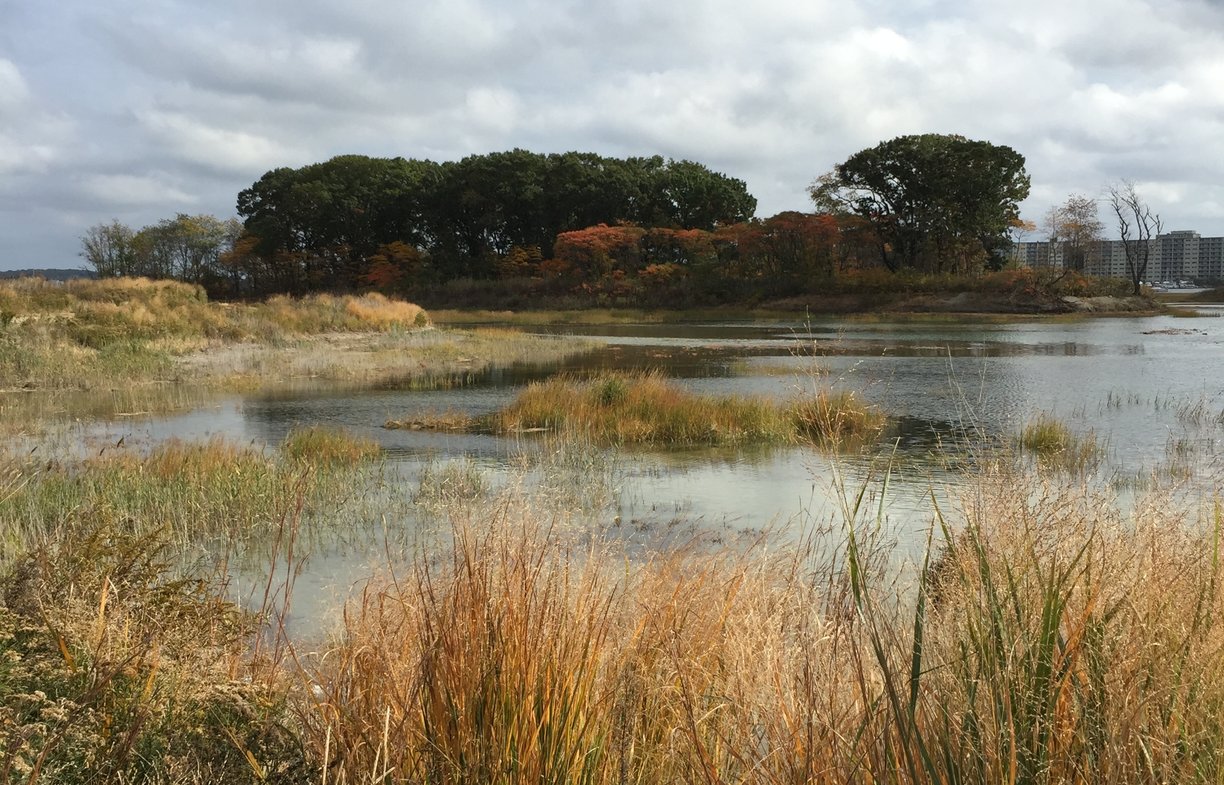Passanageset Park at Broad Meadows is part of a tidal salt marsh. Salt marshes are usually found in estuaries, where a river meets the sea, and Passanageset is no exception. The park is located near where the Town River meets the Atlantic Ocean. The salt marsh here has been significantly disturbed several times in the past century, especially by gravel excavation and by the dumping of Fore River dredging. The Broad Meadows Marsh Restoration Project, conducted by the U.S. Army Corps of Engineers between 2010-2013, returned portions of this area back to a working salt marsh and a site for passive recreation.
Salt marshes are among the most productive ecosystems on earth, and they are as valuable to us today as they were to the people who lived here thousands of years ago. They provide essential food, refuge, or nursery habitat for more than 75 percent of the fisheries we depend on. Numerous birds, mammals, and invertebrates also depend on this unique habitat, which helps buffer stormy seas, slow shoreline erosion, and absorb excess nutrients before they reach our oceans.
Salt marshes experience wide fluctuations in salinity, water, temperature, and oxygen daily. Few plants have evolved to live in these extreme conditions. Those that have, live in distinct zones based on how well they can tolerate certain conditions. The zones include the low marsh, the high marsh, and the marsh border.
The low marsh is usually flooded at every tide and is exposed at low tide. It tends to occur as a narrow band along the seaward edges, and this zone is dominated by salt marsh cord grass (sporobolis alternaflora/spartina alterniflora).
The high marsh, which receives less regular tidal influence, can be quite expansive, but the types of plants you’ll find are limited. Grasses and sedges, like saltmarsh hay (sporobolus pumilous/spartina patens), spike grass (distichlis spicata), and black grass (juncus geradii) dominate, but other common plants include perennial salt marsh aster (aster tenufolius), and sea lavender (limonium nashii).
The marsh border is usually only flooded at extreme astronomical tides and under irregular conditions, such as storm surges or wind-driven tidal inundations, and does not experience waterlogged conditions or severe salt stress. A high diversity of herbs, shrubs, and even trees exists in the marsh border. Marsh elder (iva frutescens), sweet gale (myrica gale), seaside goldenrod (solidago sempirvirens), and switchgrass (panicum virgatum) are just some of the many marsh border plants.
Since the restoration project, the amount and diversity of salt marsh flora has been increasing each year, though some of the flora growing is non-native and invasive, like common reed (phragmites australis).
Salt marshes play an important role in providing animals with feeding and nesting locations. Although animals do eat the plants of the salt marsh, the real food chain engine is the high volume of dead and decomposing materials that are moved in and out with the tides. This nutrient rich material forms the foundation of the broad web of invertebrates, fish, shellfish, birds, and mammals in salt marshes. Fish, like mummichog (fundulus heteroclitus) and herring (alosa ssp.), and invertebrates, like crabs, periwinkles, and mussels, live in tidal salt marshes.
Many species of birds feed on the abundance of small fishes and invertebrates that live in the salt marsh. Herons and egrets feed on fishes, shrimp, and crabs. Terns and ospreys dive on fish easily visible in the shallow water, while sandpipers and their relatives probe exposed mud flats for small snails and marine worms. The bird life at Passanageset is good enough to warrant a listing on the Cornell Lab of Ornithology’s E-Bird website as a birding “hotspot.” Visit http://ebird.org/ebird/hotspots and type in “Passanagest” to see the latest sightings at the park.
The dense mats of saltmarsh hay in the high marsh provide good habitat for the meadow or field mouse (microtus pennsylvanicus). Other mice that may frequent or live in the high marsh include the meadow jumping mouse (zapus hudsonius), the white-footed mouse (peromysus leucopus), and the house mouse (mus musculus). Larqer animals, such as raccoon (procyon lector), mink (mustela vison), skunk (mephitas mephitis) and weasel (mustela sp.) feed on the shellfish, bird eqqs, and mice of the marsh, although their homes are usually in upland trees (raccoon), upland dens (skunk), or under fallen logs or in hollow stumps (mink and weasel).
